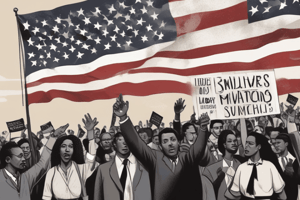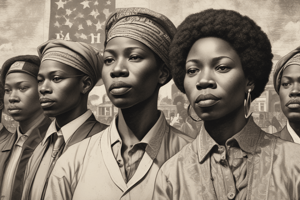Podcast
Questions and Answers
What was the outcome of the Brown v. Board of Education ruling in 1954?
What was the outcome of the Brown v. Board of Education ruling in 1954?
- Segregation in public schools was allowed
- Rosa Parks was arrested for refusing to give up her seat
- The Montgomery Bus Boycott was ended
- Segregation in public schools was deemed unconstitutional (correct)
Who led the 381-day boycott of Montgomery, Alabama's buses in 1955?
Who led the 381-day boycott of Montgomery, Alabama's buses in 1955?
- Thurgood Marshall
- Rosa Parks
- Dr. Martin Luther King Jr. (correct)
- Malcolm X
What was the primary focus of the Student Nonviolent Coordinating Committee (SNCC)?
What was the primary focus of the Student Nonviolent Coordinating Committee (SNCC)?
- Advocating for desegregation in public facilities
- Organizing interracial protests
- Promoting nonviolent civil disobedience
- Voter registration and direct action (correct)
What was the main goal of the Selma to Montgomery Marches in 1965?
What was the main goal of the Selma to Montgomery Marches in 1965?
What was the philosophy of Dr. Martin Luther King Jr.'s organization?
What was the philosophy of Dr. Martin Luther King Jr.'s organization?
What was the significance of the Student-led Sit-ins in 1960?
What was the significance of the Student-led Sit-ins in 1960?
What was the main goal of the Civil Rights movement?
What was the main goal of the Civil Rights movement?
Who delivered the iconic 'I Have a Dream' speech in 1963?
Who delivered the iconic 'I Have a Dream' speech in 1963?
Who was the leader of the Student Nonviolent Coordinating Committee (SNCC)?
Who was the leader of the Student Nonviolent Coordinating Committee (SNCC)?
What was the purpose of the Jim Crow laws?
What was the purpose of the Jim Crow laws?
What was the main outcome of the Civil Rights Act of 1964?
What was the main outcome of the Civil Rights Act of 1964?
What was Fannie Lou Hamer's main focus as a civil rights activist?
What was Fannie Lou Hamer's main focus as a civil rights activist?
Flashcards are hidden until you start studying
Study Notes
Key Events and Timeline
- 1950s-1960s: The Civil Rights Movement gains momentum in the United States
- 1954: Brown v. Board of Education - Supreme Court rules that segregation in public schools is unconstitutional
- 1955: Montgomery Bus Boycott - Dr. Martin Luther King Jr. leads a 381-day boycott of Montgomery, Alabama's buses after Rosa Parks' arrest for refusing to give up her seat
- 1960: Student-led Sit-ins - Nonviolent protests at lunch counters in Greensboro, North Carolina, and other cities
- 1963: March on Washington for Jobs and Freedom - Dr. Martin Luther King Jr. delivers his iconic "I Have a Dream" speech
- 1964: Civil Rights Act - Signed into law by President Lyndon B. Johnson, outlawing discrimination based on race, color, religion, sex, or national origin
- 1965: Selma to Montgomery Marches - Three marches, including one led by Dr. Martin Luther King Jr., to demand voting rights for African Americans
- 1965: Voting Rights Act - Signed into law by President Lyndon B. Johnson, prohibiting racial discrimination in voting
Key Figures
- Dr. Martin Luther King Jr.: Leader of the movement, advocate for nonviolent civil disobedience
- Rosa Parks: Activist who sparked the Montgomery Bus Boycott
- Malcolm X: Leader of the Nation of Islam, advocate for black nationalism
- Thurgood Marshall: Civil rights lawyer, argued Brown v. Board of Education before the Supreme Court
- Stokely Carmichael: Leader of the Student Nonviolent Coordinating Committee (SNCC)
- Fannie Lou Hamer: Civil rights activist, advocate for voting rights
Key Organizations
- National Association for the Advancement of Colored People (NAACP): Oldest and largest civil rights organization
- Southern Christian Leadership Conference (SCLC): Founded by Dr. Martin Luther King Jr. to promote nonviolent civil disobedience
- Student Nonviolent Coordinating Committee (SNCC): Student-led organization focused on voter registration and direct action
- Congress of Racial Equality (CORE): Interracial organization focused on nonviolent direct action
Key Concepts
- Jim Crow Laws: State and local laws enforcing racial segregation and discrimination
- Nonviolent Civil Disobedience: Philosophy of using peaceful protest to challenge unjust laws and institutions
- Desegregation: The process of ending racial segregation in public facilities and institutions
- Voter Suppression: Efforts to restrict or deny voting rights to African Americans
- Civil Rights: The fight for equal rights and protections under the law for African Americans
Key Events and Timeline
- The Civil Rights Movement gains momentum in the United States during the 1950s-1960s
- In 1954, the Supreme Court rules that segregation in public schools is unconstitutional in Brown v. Board of Education
- The 381-day Montgomery Bus Boycott, led by Dr. Martin Luther King Jr., begins in 1955 after Rosa Parks' arrest for refusing to give up her seat
- Student-led Sit-ins occur in 1960, involving nonviolent protests at lunch counters in Greensboro, North Carolina, and other cities
- Dr. Martin Luther King Jr. delivers his iconic "I Have a Dream" speech during the 1963 March on Washington for Jobs and Freedom
- The Civil Rights Act is signed into law by President Lyndon B. Johnson in 1964, outlawing discrimination based on race, color, religion, sex, or national origin
- The Selma to Montgomery Marches take place in 1965, with three marches, including one led by Dr. Martin Luther King Jr., to demand voting rights for African Americans
- The Voting Rights Act is signed into law by President Lyndon B. Johnson in 1965, prohibiting racial discrimination in voting
Key Figures
- Dr. Martin Luther King Jr.: Leader of the movement, advocate for nonviolent civil disobedience, and delivers the iconic "I Have a Dream" speech
- Rosa Parks: Activist who sparks the Montgomery Bus Boycott by refusing to give up her seat
- Malcolm X: Leader of the Nation of Islam, advocate for black nationalism
- Thurgood Marshall: Civil rights lawyer who argues Brown v. Board of Education before the Supreme Court
- Stokely Carmichael: Leader of the Student Nonviolent Coordinating Committee (SNCC)
- Fannie Lou Hamer: Civil rights activist who advocates for voting rights
Key Organizations
- National Association for the Advancement of Colored People (NAACP): Oldest and largest civil rights organization
- Southern Christian Leadership Conference (SCLC): Founded by Dr. Martin Luther King Jr. to promote nonviolent civil disobedience
- Student Nonviolent Coordinating Committee (SNCC): Student-led organization focused on voter registration and direct action
- Congress of Racial Equality (CORE): Interracial organization focused on nonviolent direct action
Key Concepts
- Jim Crow Laws: State and local laws enforcing racial segregation and discrimination
- Nonviolent Civil Disobedience: Philosophy of using peaceful protest to challenge unjust laws and institutions
- Desegregation: The process of ending racial segregation in public facilities and institutions
- Voter Suppression: Efforts to restrict or deny voting rights to African Americans
- Civil Rights: The fight for equal rights and protections under the law for African Americans
Studying That Suits You
Use AI to generate personalized quizzes and flashcards to suit your learning preferences.




